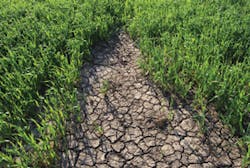The drought that’s been affecting much of the country has caused us to reconsider many things, from the type of landscaping we choose to the conservation efforts we make to how we reuse gray water. Now an interesting development is taking hold in California that manipulates the soil itself to save water: dry farming.
Dry farming has been practiced for thousands of years, especially in Mediterranean climates, and it was much more common in the US before the widespread use of irrigation. But when we started pumping water from the aquifers and diverting rivers to irrigate our crops, dry farming became a thing of the past, or at best a sort of artisanal technique used by a few growers.
The basic idea is simple: during the rainy season, you till the wet soil to loosen it up; then you compact the surface to create crust several inches thick to hold the moisture in so it doesn’t evaporate. Surface compaction might seem counterintuitive for most farming practices, but it’s essential for dry farming. The plants receive their water from below the surface rather than above, wicking up the stored water like a sponge.
Dry farming is especially suited to wine grapes and olives-two traditional Mediterranean crops-but it can also be used for growing tomatoes, onions, some melons, apricots, apples, pumpkins, winter squash, and potatoes. It requires fairly drought-tolerant varieties of plants, and crop yields are of course less than those from irrigated land. Plants must be spaced farther apart to allow each one enough area from which to draw moisture. The fruits and vegetables grown this way tend to be smaller-although some farmers claim they’re also tastier.
The most obvious advantage of dry farming is water savings; one practitioner, growing wine grapes in California’s Napa Valley, claimed to save at least 16,000 gallons of water per acre annually compared with neighboring vineyards that used light irrigation. Another advantage is that the dense, compacted top layer of soil is inhospitable to weeds, making herbicides (or weeding, if you’re farming organically) practically unnecessary. Further savings come in the form of energy that would have been used to pump irrigation water to the fields and the time and expense to maintain irrigation systems.
It won’t work everywhere; at a minimum, the land should receive 10 inches of rain annually. It also requires soils that can retain sufficient moisture, so it doesn’t work in areas with sandy soils, and because there are no year-round cover crops, very windy areas might experience more erosion. Still, agriculture accounts for about four-fifths of the water use in California, and while it’s unlikely that dry farming will catch on here on an industrial scale, more people are giving it serious consideration. If there’s an encouraging aspect to the drought, it’s that it is leading us once again to look closely at the properties of the soil itself and how best to use it.
You can find more dry farming information and case studies online at http://agwaterstewards.org/index.php/practices/dry_farming/ – studies.
About the Author
Janice Kaspersen
Janice Kaspersen is the former editor of Erosion Control and Stormwater magazines.


